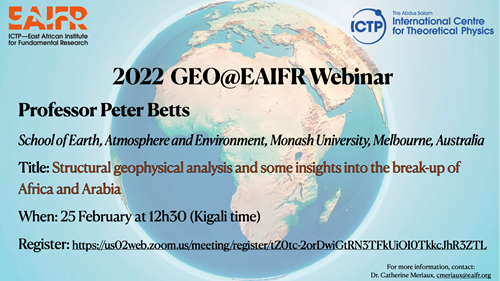ICTP-East African Institute for Fundamental Research
KIST2 Building CST
Nyarugenge Campus
University of Rwanda
Kigali, Rwanda
2022 GEO@EAIFR webinar series
Professor Peter Betts from the School of Earth, Atmosphere and Environment, Monash University, Melbourne, Australia will give the first GEO@EAIFR webinar discussing structural geophysical analysis and giving us insights into the break-up of Africa and Arabia.

The East African Institute for Fundamental Research (EAIFR, Kigali Rwanda) and the International Centre for Theoretical Physics (ICTP, Trieste, Italy) wish to inform those who may be interested of the start of the GEO@EAIFR webinar series. The 2022 series will focus on the East African Rift and its many geophysical features. Seminar will broadcast live on ZOOM. All are welcome. Below are the details of the first seminar:
Professor Peter Betts
School of Earth, Atmosphere and Environment, Monash University, Melbourne, Australia
Title: Structural geophysical analysis and some insights into the break-up of Africa and Arabia
When: 25 February at 12h30 Kigali time / 11h30 Rome time
Register: https://us02web.zoom.us/meeting/register/tZ0tc-2orDwiGtRN3TFkUiOI0TkkcJhR3ZTL
Biography:
Peter Betts is a Professor in Structural Geophysics at the School of Earth, Atmosphere, and Environment, Monash University in Australia. He is also the Associate Dean of Graduate Research, where he is responsible for the PhD and Research Masters portfolio in the Faculty of Science. Peter is the current President of the Geological Society of Australia. Peter is a geoscientist that straddles the geology-geophysics boundary. He has more than 25 years of research experience and diverse research activities that include geophysical analysis of Proterozoic basin systems, Proterozoic tectonics, and geodynamic modeling and geophysical interpretation of modern tectonic settings. He is currently undertaking research in the Red Sea, North Australian Craton, and New Zealand, and focuses his research on the influence of structural inheritance, Triple Junction initiation, and the geodynamics of congested convergent plate margins.
Abstract:
The fundamental precept of structural analysis is that descriptions of geometry provide constraints for kinematic the dynamics analysis of geological systems. Structures at all scales require a starting material heterogeneity and the mechanical response of the materials. Small scale mechanical processes (~1cm) may be quite different to regional scale processes (>1km). However, the flow fields and structures that develop are similar and therefore can be interpreted in similar ways. This structural approach is also easily applicable to analysis of regional geophysical datasets such as aeromagnetic and gravity data. Structural geophysics is a discipline defined by Jessell and Valenta, (1996).
This presentation introduces applied structural methodology and interpretation to regional geophysical datasets to unravel 3D architecture and overprinting relationships. Geophysical datasets are now often used in conjunction with structural analysis to resolve regional crustal architecture and geological evolutions. This methodology is particularly effective in remote regions and areas of limited outcrop, or if there is some ambiguity 3D structure. Aeromagnetic data is also effective interpret regional kinematics of major shear zones and high strain zones at different scales. Applying structural kinematic analysis to regional geophysical datasets informs a broad range of disciplines including, but not limited to structural analysis, plate reconstruction, tectonic analysis, and prediction of mineral systems in exploration.
We then illustrate modeling and interpretation of potential field data calling into question long held views of the evolution of the Red Sea and the Gulf of Aden. We present magnetic and gravity data from the Gulf of Aden and the Red Sea that reveal insights into some of these controversies. The data show domains that suggest diachronous and heterogeneous transition from rifting to sea-floor spreading. In these juvenile oceans, sea-floor spreading propagates towards the Afar region. We speculate that this pattern of rupturing was dictated by variations in the integrated strength of the Afar region and the rifting triple junction arms. In the southern Red Sea there appears to be two stages of ocean crust formation and the Central Red Sea is a transition zone. Collectively these observations call into questions established concepts of plume related triple junction formation. We speculate that this pattern of rupturing was dictated by variations in the integrated strength of the Afar region and the rifting triple junction arms. The weaker lithosphere and thinner crust in the Afar resulted in wide rifting mode, whereas the stronger lithosphere away from the Afar region promoted narrow rifting models.



